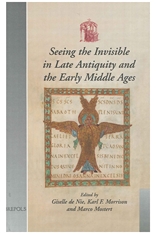 Seeing the Invisible in Late Antiquity and the Early Middle Ages, ed. Giselle de Nie, Karl F. Morrison and Marco Mostert (Turnhout, 2005: USML 14), xii+545 pp. ISBN 2-503-51759-5.
Seeing the Invisible in Late Antiquity and the Early Middle Ages, ed. Giselle de Nie, Karl F. Morrison and Marco Mostert (Turnhout, 2005: USML 14), xii+545 pp. ISBN 2-503-51759-5.
Limiting itself to the vital centuries when the late Roman West reshaped itself into a first “Europe”, the conference explored the dominant conception of human nature in that era: that human existence was both body (in the visible world of material things) and soul (in the invisible world of spirit). This was a legacy of pre-Christian elements handed down from Greek philosophy and Hebrew Scriptures. Assimilating it to indigenous cultures in the Roman West, many alien to the ancient Mediterranean world, precipitated sea-changes in the understanding of human psychology. Ensuing frictions sparked extraordinary expressions of creativity in words and visual images. It also created dangerously subversive disequilibriums in the collective mentality within élites and between them and majority cultures. The papers in this volume investigate numerous configurations of a new culture taking shape in that volatile environment. They contribute to continuing debates about the cognitive co-ordination of words and pictorial images, and to cross-disciplinary dialogues in such disparate fields as art history, religious literature, mysticism, and cultural anthropology.
Contents:
Karl F. Morrison and Giselle de Nie, “Introduction”
Part I: Late Antiquity
Looking Inward: Perceiving with the Eyes of the Mind and Heart
Andrew louth, “‘Truly Visible Things Are Manifest Images of Invisible Things’: Dionysios the Areopagite on Knowling the Invisible”
Patricia Cox Miller, “Relics, Rhetoric, and Mental Spectacles in Late Ancient Christianity”
M.B. Pranger, “Augustine and the Return of the Senses”
Looking Outward: Perceiving with the Eyes of the Body
Giselle de Nie, “‘Divinos Concipe Sensus‘: Envisioning Divine Wonders in Paulinus of Nola and Gregory of Tours”
Willemien Otten, “Ideals of Community in Late Antiquity: John Cassian and Gregory the Great on Communicating Sanctity”
Configuring the Invisible
Beat Brenk, “Visibility and (Partial) Invisibility of Early Christian Images”
Shigebumi Tsuji, “The Holy in the Dust: A Japanese View of Christendom’s Cult of the Non-Representational”
Part II: Early Middle Ages
Configuring the Invisible: Speaking
Thomas F.X. Noble, “The Vocabulary of Vision and Worship in the Early Carolingian Period”
Cynthis Hahn, “Configuring the Invisible: Depicting Metaphor and Meaning in Early Medieval Reliquaries”
Erik Thunø, “Materializing the Invisible in Early Medieval Art: The Mosaic of Santa Maria in Domnica in Rome”
Herbert L. Kessler, “‘Hoc Visibile Imaginatum Figurat Illud Invisibile Verum‘: Imagining God in Pictures of Christ”
Configuring the Invisible: Enacting
Celia Chazelle, “Amalarius’s Liber Officialis: Spirit and Vision in Carolingian Liturgical Thought”
Configuring the Invisible: Dialectic between Words and Pictures
Bianca Kühnel, “Carolingian Diagrams, Images of the Invisible”
Sabine MacCormack, “The City Built in Heaven”
Limits of the Possible
William Diebold, “The Carolingian Idol: Exegetes and Idols”
Paul Edward Dutton, “Carolingian Invisibles and Eriugena’s Lost Vision of God”
Karl F. Morrison, “Nudity Lost and Regained in Eriugena’s History of the World”
Marco Mostert and Jean-Claude Schmitt, “Analytical Postscript”

